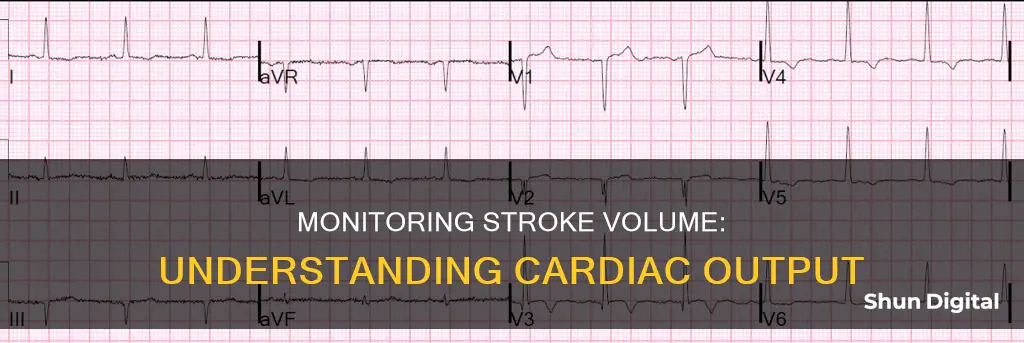
Stroke volume is a crucial indicator of health and efficiency, referring to the volume of blood pumped by the heart with each contraction. It is typically calculated within the context of cardiac output assessment, which requires knowledge of various physiological parameters such as heart rate, end-diastolic volume, and end-systolic volume.
To determine stroke volume, one can employ various methods, including non-invasive techniques like echocardiography, Doppler ultrasound, and impedance cardiography, as well as invasive procedures such as cardiac catheterization and thermodilution.
The stroke volume formula is:
> Stroke volume = End-Diastolic Volume (EDV) - End-Systolic Volume (ESV)
This calculation is essential for healthcare professionals in diagnosing cardiac conditions, monitoring patient health, and guiding treatment strategies effectively.
| Characteristics | Values | |
|---|---|---|
| Stroke volume definition | The volume of blood pumped by the heart (from the left ventricle) in the systemic circulation during one contraction or heart beat. | N/A |
| Stroke volume calculation | SV = EDV – ESV | |
| Stroke volume calculation using cardiac output | SV = Cardiac output/Heart rate | |
| Stroke volume calculation using Doppler VTI method | SV = π x (LVOT/2)2 x LVOT VTI x 0.01 | |
| Stroke volume calculation using Fick principle | CO = VO2 / (Ca - Cv) | |
| Normal stroke volume range | 60 to 120 mL | |
| Normal stroke volume range for athletes | Up to 200 mL | |
| Factors that increase SV | Increased venous return, decreased vascular resistance, sympathetic stimulation, epinephrine and norepinephrine stimulation | |
| Factors that decrease SV | Increased vascular resistance, sodium and potassium concentrations, calcium channel blockers, parasympathetic stimulation |
What You'll Learn

End-diastolic volume (EDV)
EDV is typically measured using imaging techniques such as echocardiography or cardiac catheterization. Echocardiography uses ultrasound technology to create detailed images of the heart, while cardiac catheterization involves inserting a thin, flexible tube called a catheter into a large blood vessel and guiding it into the heart. These procedures allow doctors to measure EDV and other cardiac parameters to assess heart function and health.
The formula for calculating stroke volume is: Stroke volume = EDV – End-Systolic Volume (ESV). ESV is the volume of blood remaining in the ventricle after the heart contracts. By measuring EDV and ESV, doctors can calculate stroke volume, which is the volume of blood pumped by the heart with each contraction. This is a crucial indicator of heart health and can help diagnose and monitor various cardiac conditions.
In addition to echocardiography and cardiac catheterization, other methods for determining EDV include the thermodilution technique, Doppler techniques, and impedance cardiography. The thermodilution technique involves injecting a cold solution into a central vein and measuring temperature changes as the blood mixes in the pulmonary artery. Doppler techniques use Doppler ultrasound to measure blood flow velocities, while impedance cardiography measures changes in electrical impedance across the chest with each heartbeat.
EDV is an essential parameter in cardiovascular physiology, providing valuable insights into cardiac function and health. By understanding EDV and its role in calculating stroke volume, healthcare professionals can make informed decisions for patient care and enhance outcomes.
Monitoring Employee Internet Usage: Company Strategies and Tactics
You may want to see also

End-systolic volume (ESV)
The end-systolic volume index (ESVI) is calculated by dividing ESV by body surface area (BSA) and is used to correct for BSA. The ventricular outflow tract and papillary muscles should be included in the calculation. However, the muscles should be included in either blood volume or mass, but not both.
Normal ESV values vary depending on age, gender, imaging modality, and whether the left or right ventricle is being measured. Higher-than-normal values may indicate systolic dysfunction.
Monitoring Power Supply Usage: A Comprehensive Guide
You may want to see also

Calculating stroke volume using cardiac output
Stroke volume is a crucial metric in assessing cardiac function and overall health. It refers to the volume of blood pumped by the heart with each contraction. This value is often used in anesthesiology to measure recovery after anaesthesia.
To calculate stroke volume, one must first understand its components: End-Diastolic Volume (EDV) and End-Systolic Volume (ESV). EDV is the volume of blood in the ventricles at the end of diastole before contraction, while ESV is the volume of blood in the ventricles at the end of systole after contraction. These values can be determined through imaging techniques like echocardiography or invasive procedures like cardiac catheterization.
Once EDV and ESV are known, the stroke volume can be calculated using the following formula:
> SV = EDV – ESV
However, stroke volume can also be calculated using cardiac output. Cardiac output (CO) is the volume of blood pumped by the heart in one minute and is calculated by multiplying stroke volume by heart rate:
> CO = SV x Heart Rate (HR)
Therefore, to calculate stroke volume using cardiac output, we can rearrange the formula as follows:
> SV = CO / HR
This method is particularly useful when cardiac output and heart rate are measured directly or estimated through other means.
For example, let's assume a cardiac output of 6 litres per minute and a heart rate of 80 beats per minute. Using the formula, we can calculate the stroke volume as follows:
> SV = 6 / 80 = 0.075 litres = 75 millilitres
It's important to note that stroke volume values can vary depending on factors such as age, gender, body size, and cardiac health. Regular stroke volume values typically range from 60 to 120 mL per beat, but can reach up to 200 mL for athletes.
Monitors with 17-inch Displays: Are They All Uniform in Size?
You may want to see also

Non-invasive measurement methods
- Pulse wave velocity and aortic dimensions: The Bramwell-Hill equation relating pulse wave velocity to aortic compliance is applied. The aortic compliance can be determined from aortic pulse wave velocity and aortic volume, both of which can be measured noninvasively. The stroke volume can then be determined from systolic and diastolic blood pressure and compliance.
- Electrical bioimpedance: Electrical bioimpedance cardiography (CO-EBI and SV-EBI) estimates cardiac output by correlating changes in thoracic impedance with changes in thoracic blood volume due to cardiac filling and ejection.
- Arterial blood pressure analysis: The Modelflow algorithm (CO-MF and SV-MF) computes cardiac output by applying each beat of the arterial blood pressure waveform to a three-element non-linear arterial model. The long-time interval method (CO-LTI and SV-LTI) estimates cardiac output by analysing a continuous arterial blood pressure waveform and extracting information from the inter-beat or beat-to-beat variations. Pulse pressure (CO-PPHR) is also used as a quantitative correlate of stroke volume.
Monitoring Virtual Memory Usage: A Comprehensive Guide
You may want to see also

The impact of exercise
Stroke volume is the volume of blood pumped by the heart in every beat. During exercise, the body's demand for oxygenated blood increases, and the heart must pump more blood to meet this demand. This is achieved through an increase in cardiac output, which is the volume of blood pumped by the heart per minute. Cardiac output is influenced by two factors: heart rate and stroke volume. During exercise, the heart rate increases linearly, while the stroke volume increases non-linearly.
In sedentary or moderately active individuals, stroke volume may reach a plateau or even decrease during submaximal exercise loads. This is because, at high workloads, the increase in heart rate is accompanied by a decrease in end-diastolic volume, which can lead to a decline in stroke volume. On the other hand, athletes tend to exhibit an increased stroke volume during maximal exercise loads due to their higher level of physical fitness.
In summary, exercise increases the demand for oxygenated blood, leading to an increase in cardiac output. This increase in cardiac output is achieved through a combination of a linear increase in heart rate and a non-linear increase in stroke volume. The extent of this increase in stroke volume depends on various factors, including age, gender, physical fitness level, and body position during exercise. Therefore, it is essential to consider individual characteristics when interpreting stroke volume values and comparing them across different populations.
Factors to Consider When Choosing the Right Monitor Size
You may want to see also
Frequently asked questions
The formula for calculating stroke volume is:
> SV = EDV - ESV
Where SV is the stroke volume, EDV is the end-diastolic volume, and ESV is the end-systolic volume.
The formula for calculating cardiac output is:
> CO = SV x HR
Where CO is the cardiac output, SV is the stroke volume, and HR is the heart rate.
There are several methods for determining stroke volume, including:
- Echocardiography
- Cardiac catheterization
- Thermodilution technique
- Doppler techniques
- Impedance cardiography







